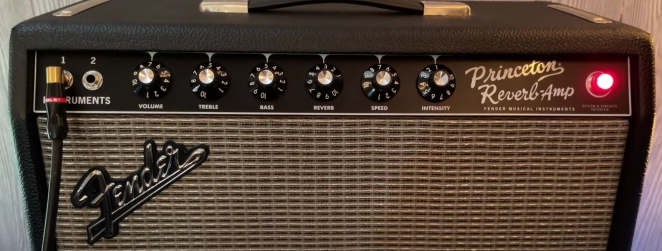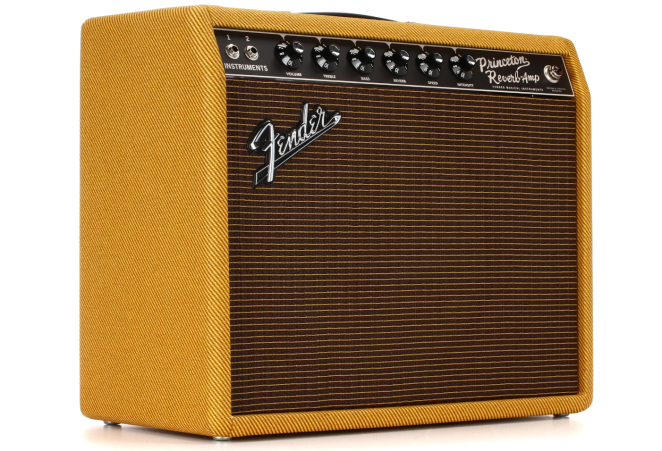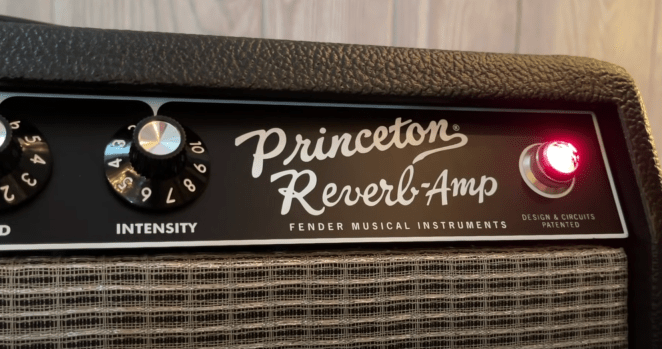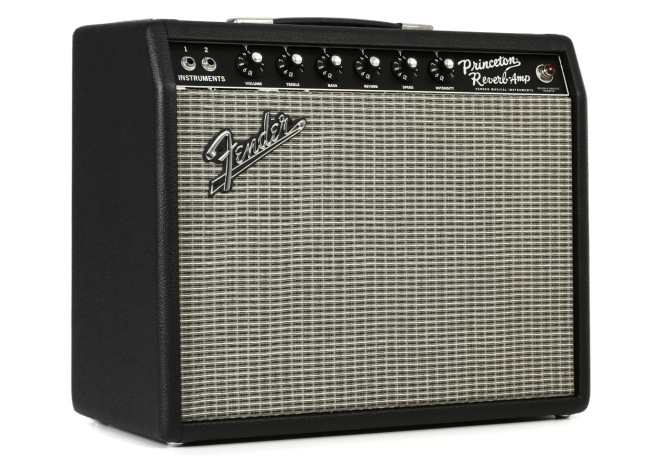The iconic Fender Princeton Reverb is a timeless tube amp first created by Fender in the 1960s, designed to provide great Fender tube tone in a compact package. Though it may have originally been designed as a practice amp, the Princeton soon became a staple of studios and small gigs.
Videos by American Songwriter
In this review, I’ll take a good, hard look at the Fender ’65 Princeton Reverb reissue [spoiler: I love it] and make a case for why you might want to consider going the route of this nearly period-correct reissue rather than shopping for pricey, delicate antiques.
First, I’ll kick this review off with a quick primer on what this deceptively simple little amp has to offer.
Fender ’65 Princeton Reverb Overview and Specs
While vintage Fender amps have become highly sought-after collectibles (and pretty pricey ones, at that) the Fender ’65 Princeton Reverb reissue is an affordable, road-ready alternative.
A single 10″ Jensen speaker delivers 12 watts of classic Fender sound courtesy of Fender’s painstakingly re-created Blackface circuitry, known for its glassy clean tones at lower volume and warm saturation when cranked.
Not to mention one of the most iconic reverb and tremolo combinations of all time, which you can control via an included two-button footswitch.
As for the cabinet itself, it’s sturdily constructed and comes with a tough textured vinyl covering that makes transportation a breeze. Despite weighing in at around 34 lbs, the Princeton’s compact size makes it a perfect companion for the road, giving you more than enough power for most small club gigs.
Why I Like It
- Rugged construction will stand up to the rigors of the road
- Cool vintage sound
- Affordable price point
- Great tone at low volumes
- Perfect studio amp
Room For Improvement?
- The only downside, and it’s a small one, is that the stock tubes are of lesser quality than the ones included with the original back in the day, and could use an upgrade
Specs
- Type: Tube
- Number of Channels: 1
- Total Power: 12W
- Speaker Size: 1 x 10″ Jensen C10R
- Preamp Tubes: 3 x 12AX7, 1 x 12AT7
- Power Tubes: 2 x 6V6 (power), 1 x 5AR4 (rectifier)
- Reverb: Yes
- Effects: Vibrato
- EQ: Treble, Bass
- Inputs: 2 x 1/4″ (1, 2)
- Outputs: 2 x 1/4″ (8 ohms, external speaker)
- Footswitch I/O: 1 x 1/4″ (reverb, vibrato)
- Bias Type: Adjustable Fixed
- Construction Material: Lacquered Tweed (Sweetwater Exclusive), or Textured Vinyl on Birch Ply
- Power Source: Standard IEC AC cable
- Height: 16″
- Width: 19.87″
- Depth: 9.5″
- Weight: 34 lbs
Princeton Deep Dive
Now that we’ve looked at the Fender ’65 Princeton Reverb from a bird’s eye perspective, it’s time to get into the nitty-gritty.
Tone & Sound Quality (4.5/5)
The classic circuity of a 1965 Fender Princeton Reverb has been preserved in this modern reboot. In short: it sounds like a Fender amplifier. This single-channel amp sounds great at low volume, with a fair amount of clean headroom, and breaks up nicely when pushed a bit.
The standard “Blackface” ’65 Princeton comes stock with a 10″ Jensen Special Design C-10R speaker that’s voiced perfectly to the amp.
Also worth looking into, however, is the Sweetwater exclusive Lacquered Tweed ’65 Fender Princeton Reverb, which boasts a 12″ Eminence Cannabis Rex stock speaker that’s clear and smooth with tight midrange definition and sparkling highs.
[Check out our guide to the best guitar speakers to learn more about this underappreciated tone-shaping factor.]
Power & Wattage (3/5)
There’s no denying that the Fender Princeton Reverb is a smaller amp, but its 12-watt output is robust enough to move some air, while almost always staying at a reasonable volume for rehearsals, recording, and smaller club gigs.
It definitely won’t be the best choice for a heavy metal gig, but it’s the right amp for tasteful, low-volume gigs and rehearsals, especially if you work in the classic rock, country, and blues genres.
Features & Controls (4/5)
From an EQ perspective, the Princeton has treble and bass controls, with a master volume control, reverb control, and speed and intensity knobs for its delicious vibrato. A two-button footswitch pedal lets you control the reverb and vibrato. Simple, sleek, timeless, and effective.
The preamp tube combination of three 12AX7s, and a single 12AT7, combined with a pair of 6V6 power tubes and a 5AR4 rectifier provide lush clean tones and tasty natural overdrive. But again, one of the easiest and most effective upgrades you can perform is to swap out the tubes to your liking.
Build Quality & Durability (4/5)
Fender makes the Princeton amp with gigging in mind. It’s solidly constructed, with black textured vinyl or lacquered tweed covering a birch plywood cabinet, and includes a textured vinyl amp cover to protect it in transit. Weighing in at only 34 lbs, the Princeton is a portable tone machine.
Tube amps are delicate creatures, but they’ve come a long way in terms of durability, and Fender amps are about as tough as they come.
Things To Consider
By now you should have a pretty good picture of what the Fender Princeton offers. A wonderful-sounding guitar amp offering crystal clean tones, with the ability to get a little gritty at high volumes.
It’s a great amp for the studio, or rehearsal spaces, but may not be the best option if you’re looking for something thunderously loud. However, odds are that if you’re this far into an article about the Fender Princeton, you know what you’re looking for. Trust your instincts.
Power and Volume
When shopping for a tube combo amp, one of the main things you’re going to want to consider is the power and volume needed.
Tube amps are notorious for sounding their best at high volumes, and in some cases, that can be really, really loud. As in, louder than you can get away with at home, rehearsal, or even in some venues. And you’re just going to be paying more than you need to for power you’re never going to use.
The Princeton Reverb, however, is a perfectly sized tube amp for most players. You get incredible cleans from 1-3 that are still reasonably audible, incredible sensitivity and dynamics in the sweet spot from about 4-6, and killer tube distortion from about 7 and onwards.
You can use it in the studio, mic’d onstage at most venues, and even at home in some cases (namely, if you don’t share any walls) at a level that’s going to coax out some of the best tones but won’t blow your eardrums.
Onboard Effects and Features
Tube amps aren’t known for having a ton of effects and features. The most you’re usually going to get is an onboard spring reverb and sometimes a drive or boost channel.
That being said, the Princeton Reverb comes with two of the most beloved onboard analog effects in the guitar world: a classic spring reverb and a sweet, versatile vibrato that can be heard on tons of classic rock and soul records.
If it’s tons of different effects presets you’re after, you’d best look elsewhere. But if you want a few classic analog effects and genuine tube distortion, the Princeton is actually pretty versatile.
And with its glassy cleans, it’s also a great pedal platform at lower volumes.
Sound Quality
Now, we’ve already discussed at great length the tone qualities of the Princeton Reverb. But it’s worth mentioning one more time that, if you’re looking for tube tone specifically, this amp is a great choice.
Working with tubes has its drawbacks, such as maintenance costs, warmup time, and fragility in transport, but nothing beats the warm, rich tones of a Fender tube amp.
If, however, you want a cleaner sound with more headroom for using tons of different effects with, or playing genres like post-punk or fusion, you might be better off with a solid-state amp like the Roland Jazz Chorus.
Likewise, if it’s a grittier, heavier sound you want, there are other offerings from Fender that would suit you better, like the Hot Rod DeVille with its extra-dirty drive channel, or choices from Orange, Marshall, and Vox that can get a bit hotter.
We’ll look into a few of these alternatives below.
Size and Portability
Finally, if you need a tube combo amp that you can carry reliably with one hand, the Princeton Reverb is it. At only 35 lbs and 20 inches across, it’s small enough to fit in the trunk or backseat of a small car and won’t give you back problems – ideal for working musicians on the go.
I’ve heard it said that the Fender Deluxe Reverb is the perfect one-size-fits-all amp for most players, but I honestly think it’s overkill for most situations, especially the studio, where power is not what matters most. The Princeton is a much better candidate for the perfect-sized combo amp if you ask me.
Alternative Options
We’re realists here at American Songwriter, and we know that the best tube amp for you will depend on your personal preferences, playing style, and budget. So with that in mind, let’s look at some possible alternatives to the Princeton.
Fender Princeton vs Fender Vibro Champ
The Fender Vibro Champ is an even smaller amp, offering up just 5 watts of tube-driven Fender tone. Studio rats love the Champ because you can crank it up to maximum volume and still fit neatly within a music ensemble.
Similarly to the Princeton, the Champ offers on-board reverb and vibrato. If you think the Princeton might be too much amp, give the Champ a look.
Fender Princeton vs Fender Blues Junior
The Fender Blues Junior amp is a blues rock classic, found in countless bedrooms and rehearsal spaces. It can’t quite compete with the quality of the Princeton, but it’s also nearly half the price, and a fine option for someone looking to take the next step and invest in a tube amp, but not quite ready to step up to the Princeton.
Take a look at our full review of the Fender Blues Junior IV for more information.
Fender Princeton vs VOX AC15
Vox may forever be linked to the sound of the British Invasion, but the AC15 is no one-trick pony. With two channels at 15 watts and a unique sound all its own, the Vox AC15 (full review here) is a great-sounding amp and has to be considered a viable alternative to the Princeton.
If you’re looking for more emphasis on drive and grit, the AC15 may be more your speed than the Princeton, which is prized more for its clean tones and warm saturation than flat-out overdrive.
Conclusion
If you’re looking for a small amp that offers high-end clean Fender sound, the 65 Princeton Reverb is a fantastic option. True vintage vibe can be hard to find in a new amp, but the Princeton delivers.
Whether you’re looking to dial in the perfect studio tone or need a reliable option for small- to medium-sized stages, this Princeton reissue is a dependable, durable, and downright dreamy-sounding tube amp.





